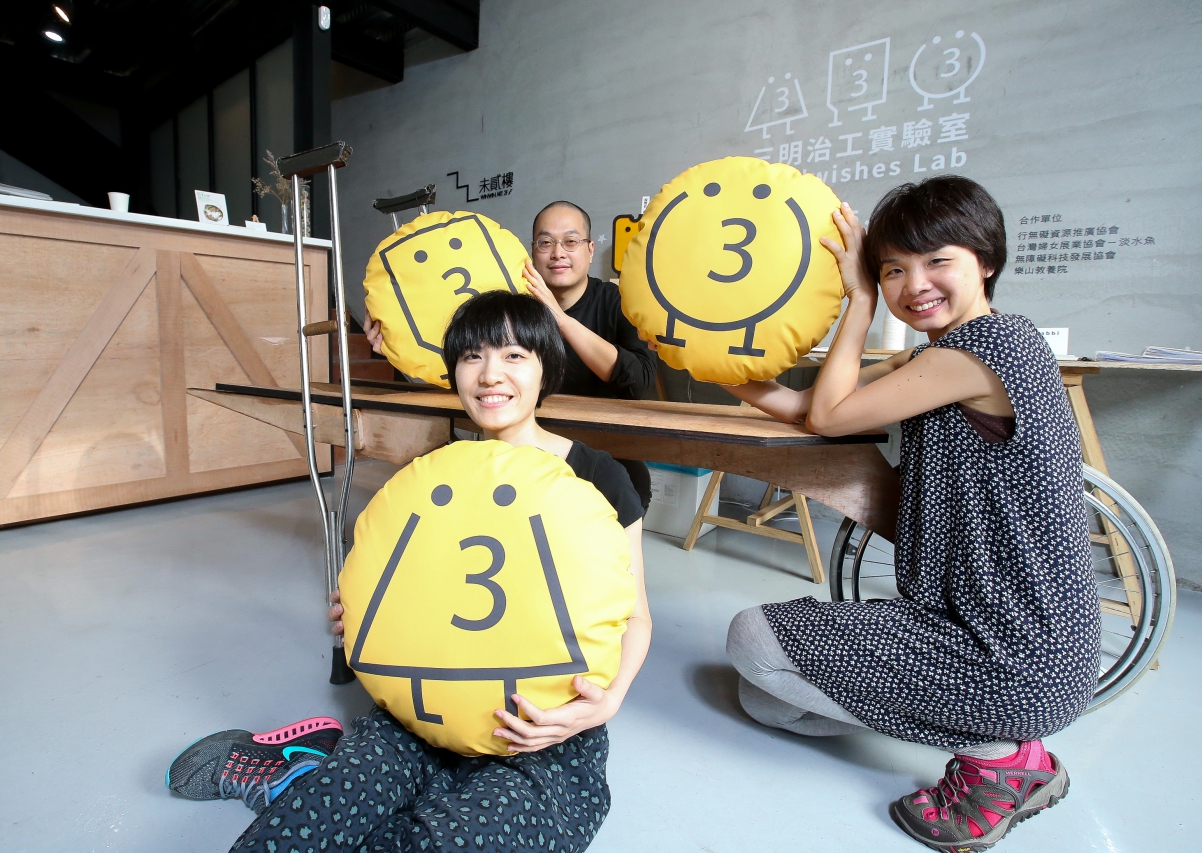走進「三明治工」位於芝山的工作室,可以看到不少新奇有趣的展品,充滿團隊歷年來的創意成果。例如以輪椅扶手改良而成的不求人,或者按照漸凍人呼吸痕跡製成的玻璃杯,令人好奇之餘,也引發關於設計理念的思索。引人注目的,還有工作室內大片以雷射雕刻技術製成的展用隔間,為空間增添更多設計色彩。在隔間之後,「三明治工」的創辦人之一李萬鏗,向我們打招呼並笑著遞上名片,上頭除了文字資訊,還有專為盲人同胞設計的點字版本,顯見其對共融價值的注重。
什麼是「三明治工」呢?他們賣的可不是三明治,而是透過策展與設計,以公益創新和共融價值為目標,創造社會參與的新可能。選擇這條少見的非典型創業路線,有媒體將他們定位為「社會企業」,李萬鏗卻認為,或許他們還是比較像「藝術團隊」。
字面上,「三明治工」是「三名志工」的諧音,似乎十分符合他們處理公益議題的方式。李萬鏗笑著說,簡單的四個字涵義雖有些模糊,有很大的解讀空間,加上唸起來很順,就決定使用到現在。這些年接觸的案例經驗,讓他漸漸對這個名字有了自己的詮釋:如同團隊一路走來的發展模式,正是不斷將特定社會價值與意義疊加在一起,創造出新的事物。
「一開始的想法是藝術與設計結合公益的跨界合作,透過展覽、活動和商品等不同合作案例,持續累積和嘗試……」將「公益」元素導入設計流程,與「藝術」連結起來的實踐,是為三明治工早期的工作方向。他回憶道,這個發展契機源自研究所時期修習的「藝術參與社會」課程,當時在老師帶領下來到樂山教養院,以院方的身心障礙生為對象,延伸出將園區回收物製成樂器的創作計畫,與院生一同歌唱、演奏,將藝術與設計資源帶進了截然不同的領域。
早在2006年,李萬鏗即從香港來到臺灣唸書,在求學階段意識到自己並不想從事純藝術創作,於是開始思考,未來在藝術領域裡,還有什麼道路可以選擇?適逢國立臺北藝術大學藝術跨域研究所的招生,吸引他進入就讀,為自己的疑惑尋找答案。這次與樂山教養院的合作經驗,開啟了他們將近十年的長期合作關係,不僅替樂山改造門面,也協力將院生的繪畫作品以紅包、T-shirt、月曆、紙膠帶等形式販售,甚至舉辦以名人肖像為主題的畫展;更重要的是,他找到了體制外的不同路線,將創作轉變為能讓更多人參與的形式,並持續朝這個方向探索。
2012年年底,李萬鏗與北藝大的同學謝若琳、曾韻潔三人登記成立三明治工,隔年開始正式運作。同為藝術背景,團隊分工依照需求各司其職,李萬鏗負責主要設計,但總體設計、文案等企劃皆會由三人一同發想。早期成員間的溝通傾向藝術本位,很難擺脫藝術創作的思維。現在的三明治工歷經成員更迭,李萬鏗仍然是核心人物,然而不同背景的人加入討論,也拓寬了團隊面貌,不過最初的「三名志工」,偶爾還是會一起討論未來發展。

起初,大部分單位可能都想複製樂山的成功模式,三明治工接到的案子來源大多相似,多屬於商品開發或展覽策劃。後來,提供設計服務以外,他們開創了「三明治工實驗室」,將合作單位的想法化為充滿創意的藝術計畫,試圖改變公益想像的模樣。2015年,三明治工實驗室與行無礙資源推廣協會合作,從無障礙空間的倡議發想出「極速傳說.城市障礙賽」,蒐集臺灣各處荒謬、無效的無障礙設施,諸如過陡的斜坡或引人撞牆的導盲磚,將之轉換為藝術體驗。他們以回收的輔具零件製成障礙跑道,讓參與者操控遙控車進行挑戰,即時畫面則同步到展場中的大螢幕上,讓參與者能體驗臺灣的無障礙路況有多麼不友善。同時,他們也將廢棄輪椅改裝成展示車,把壞掉的扶手做成不求人――象徵著只要有足夠條件,其實可以不需要別人協助便能自主完成。
「很多社會參與,大家都知道是對的,卻不會真的去做。要改變這件事,就需要讓這些議題『有感覺』,用體驗的方式讓大家知道,很多事都與自己有關。」李萬鏗解釋道,就像無障礙空間的議題,其實並不只與身障者相關,嬰兒車的使用者、送貨員、長者等不同族群都可能遇到同樣的問題。在藝術與公益實驗的框架下,三明治工確立出「一起玩」的創作方向,透過「一起玩」讓人們「有感覺」,成為他們重要的理念。「我們越玩越開心,畢竟這是我們自己發起的計畫,只要預算成本控制好,想到什麼就可以做。」
從藝術和設計出發,三明治工不使用過於複雜的概念,標語和文字也採用親民易讀風格,往往能讓人在體驗過程有所感受。當他們遇到展示空間裡的高低差,就用裱框店廢材把它化為小斜坡,克服環境的障礙問題;和無障礙科技發展協會合作時,接觸到點字機打字,便設計出「敲敲話信箱」,將參與者的話轉譯為點字卡片寄出,藉由解碼表將視覺轉換為觸覺的認識;經過公民團體和在地兒童工作坊的討論,他們結合在地故事、自媒體時代的資訊行為,把常見的模組化公園遊具改造成異想天開的「飛碟頻道」,受到大小朋友喜愛。
 「飛碟頻道:公園不再大眾臉」計畫中,三明治工將過去模組化的公園遊具重新設計。圖/三明治工提供
「飛碟頻道:公園不再大眾臉」計畫中,三明治工將過去模組化的公園遊具重新設計。圖/三明治工提供
 2018年三明治工策劃新北市共融藝術節特展,以「無限機場」為題設計展場。圖/三明治工提供
2018年三明治工策劃新北市共融藝術節特展,以「無限機場」為題設計展場。圖/三明治工提供
漸漸地,三明治工的創作理念由公益過渡到共融,讓合作對象參與計畫的份量變得更重了。當食品單位請三明治工製作具公益性質的茶禮盒,他們規劃了工作坊,請樂山院生用茶葉拼貼成外包裝的封面設計,後續更延伸至製成工序的參與,請婦女協會成員代工包裝。「從這裡開始思考,創作跟工作都是我們想開發的參與社會的方式。後來的很多案子,我們不希望都是在幫對方講話,而是要成為一個平台,讓他們可以透過我們的計畫來講自己的故事。」李萬鏗以「呼吸杯」為例:這是一件關於漸凍人的作品,但可能連手腳都無法移動的病友,要如何參與?他們認為「呼吸」議題是生存的基本,亦是病友能一起參與的方法。這所謂的「一口氣」貫徹在產製與使用流程:他先以特製鏡頭記錄病友呼吸的水氣痕跡,接著交由口吹玻璃師傅製成玻璃杯,而使用者喝水時也會在裡頭留下一口氣,潛在連結了社會上不同角色的關係。
2018年,新北市首次以「共融藝術節」舉辦特展,三明治工策劃了「無限機場」,將過去的經驗融合到展覽之中。「我們在思考要用什麼方式來談論『共融』?沒有經歷過意外或身體殘缺,很難同理某些人的處境,但不代表一般人就不能講這件事。於是我開始思考,什麼是人類最大的障礙?」那時,李萬鏗想到的答案是飛行――人類生來不會飛,透過發明和想像卻得以飛翔。借助人人都有的童年回憶,三明治工將展場變成了放紙飛機的障礙場地,面對需要穿越障礙物的、垂直、彎曲,甚至旋轉360度飛行的關卡,玩家可以參照說明書,摺出不同性能的紙飛機來克服問題。從機場需要服務不同族群的概念延伸思考,李萬鏗更針對玩家需求設計出相應輔具:手部功能較弱者,可以使用簡易又穩定的紙飛機發射器;坐輪椅的朋友或老人家,也能夠利用團隊設計的撿物夾拿回掉落的紙飛機。
延續過往創作與工作的合作模式,三明治工也帶領身心障礙的朋友參與工作坊,如同培養能力的小型作業所,將摺紙飛機的步驟拆解到十分詳細的程度,再附上核對板,讓每個人都能順利完成,正如展場的標語「沒有人會飛,但所有人都可以飛」。「我們的概念在『無限機場』已經很完整,整個模式也越來越具體。展覽、工作坊、畫展都是某一種形式,可以再拆成不同事件,比如從創作中開發社會參與的可能性,或者一起工作的生產路徑,讓對方從被幫助的人變成生產者。」李萬鏗說,他們曾經請來身心障礙者參與佈展和顧展,透過這樣的合作逐步改善相應措施,以後就有可能變成新的生產機制,也會是另一種扭轉刻板印象的社會參與方式。他指著身後自製展用隔間解釋道,那是他研發中的產品,目前大約能在半小時內現場組裝完畢,降低佈展難度、實現理念之外,未來也可望開發成租借系統,更大程度地自由運用。「做展覽很自然會想到找廠商去處理,但有時候把『生產』這件事拿回來考量,其實就能夠有很不一樣的產出。」
聽李萬鏗分享三明治工的故事,每個案例都饒富興味,不只訝異於他們將平凡化為新奇的設計能力,也佩服行動背後,更具同理心的多元思考。近年,隨著文化近用、資訊平權的意識提升,他們與不同單位合作設計易讀手冊,藉由降低閱讀門檻,減少因為資訊落差造成的判斷失衡。目前的成果包括和中央選舉委員會合作的選舉指南、替國立故宮博物院設計的導覽手冊等,將抽象或繁複的文字,化成簡白的資訊,進而保障每個人參與社會與文化的權益。
關於設計的實作面向,李萬鏗也分享了「數位製造」的技術,比如3D列印或雷射雕刻,透過電腦的協助,讓他得以更即時、也更有彈性地創作,「將生產方法由大量生產變為個人製造――但不一定是製造物件,也可能是生活經驗。」2018年,他赴瑞典駐村,和當地自造實驗室(Fab Lab)合作,以雷射雕刻的製作方法,將當地宜人的秋季氣候經驗化為《秋天工廠》,無論何時何地,拉動機具的引繩即可掉出落葉。
 《記憶樹報攤》以兼具氣味、聲音、影像等文史記憶的互動裝置呈現。圖/三明治工提供
《記憶樹報攤》以兼具氣味、聲音、影像等文史記憶的互動裝置呈現。圖/三明治工提供
「早期我們的實驗重心在藝術與公益合作,接下來我會去實驗跟在地的連結,拓展可以做的事情的可能性。講到公益大家會有既定想像,其實只要能讓大家一同參與生產路徑,任何商業案都可以做。」將前作的概念延續深化,2019年大稻埕藝術節,互動裝置的掉落物件換成了老新聞、書信或手稿,承載舊時對臺灣政治的想像與看法;2020年國家文化記憶庫成果展,《記憶樹報攤》更升級為收錄實體物件、氣味、聲音、影像等文史記憶的互動裝置。
「以前覺得跨領域好像要打破某些框架,現在覺得是將不同框架結合起來,我會列出一個自我的方向,在底下去做事情。」李萬鏗說,一直覺得自己在打游擊戰,累積了多年經驗,許多想法慢慢整合在一起,也在現有的藝文生態中做出一些市場辨識度。未來,他打算朝數位內容的方向發展,進一步嘗試結合易讀資訊的理念,讓生活變得更容易。當然,有趣還是必要的,「工作、創作、藝術創作都是,我現在的框架基本上就是『一起玩』。」